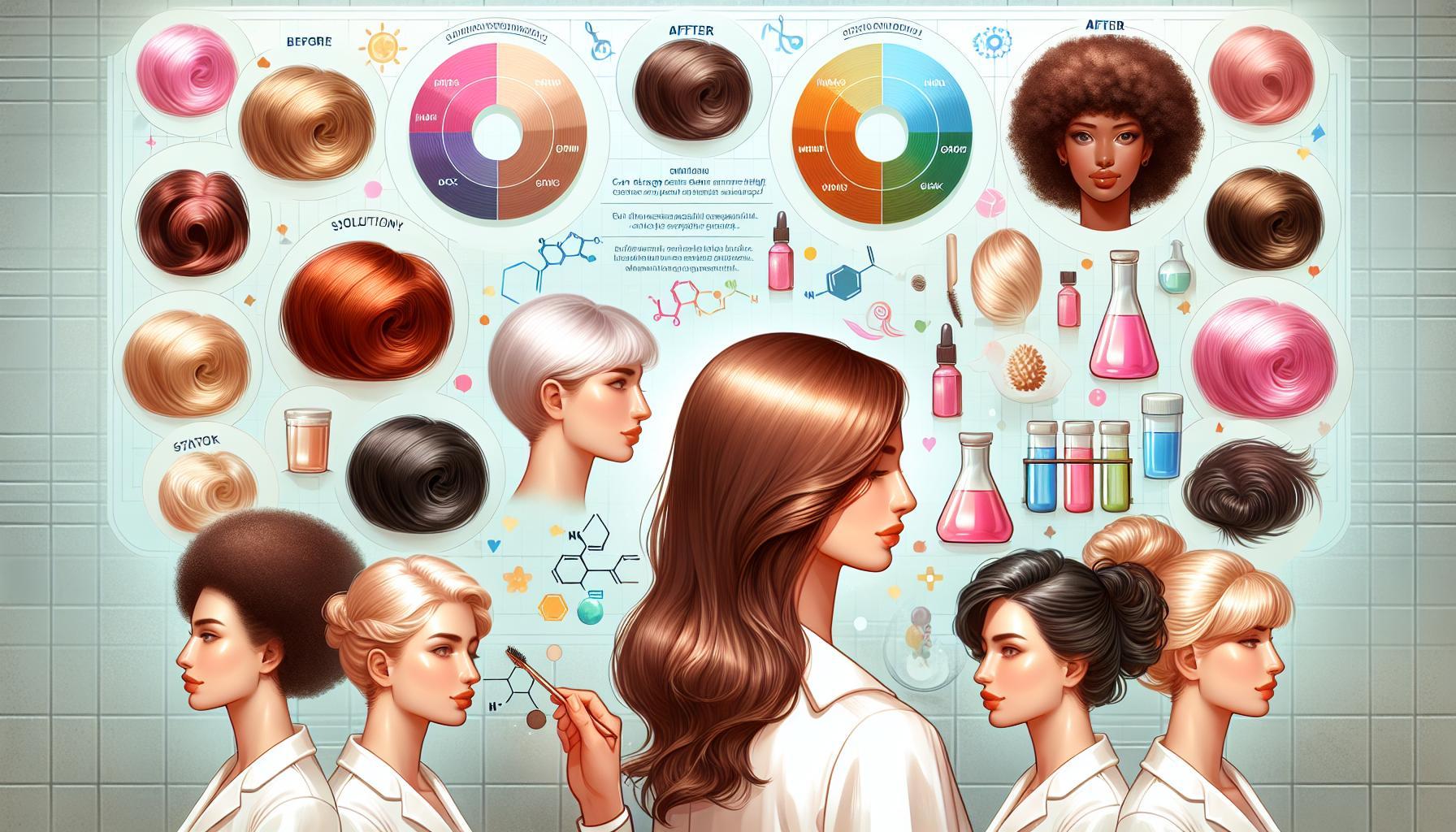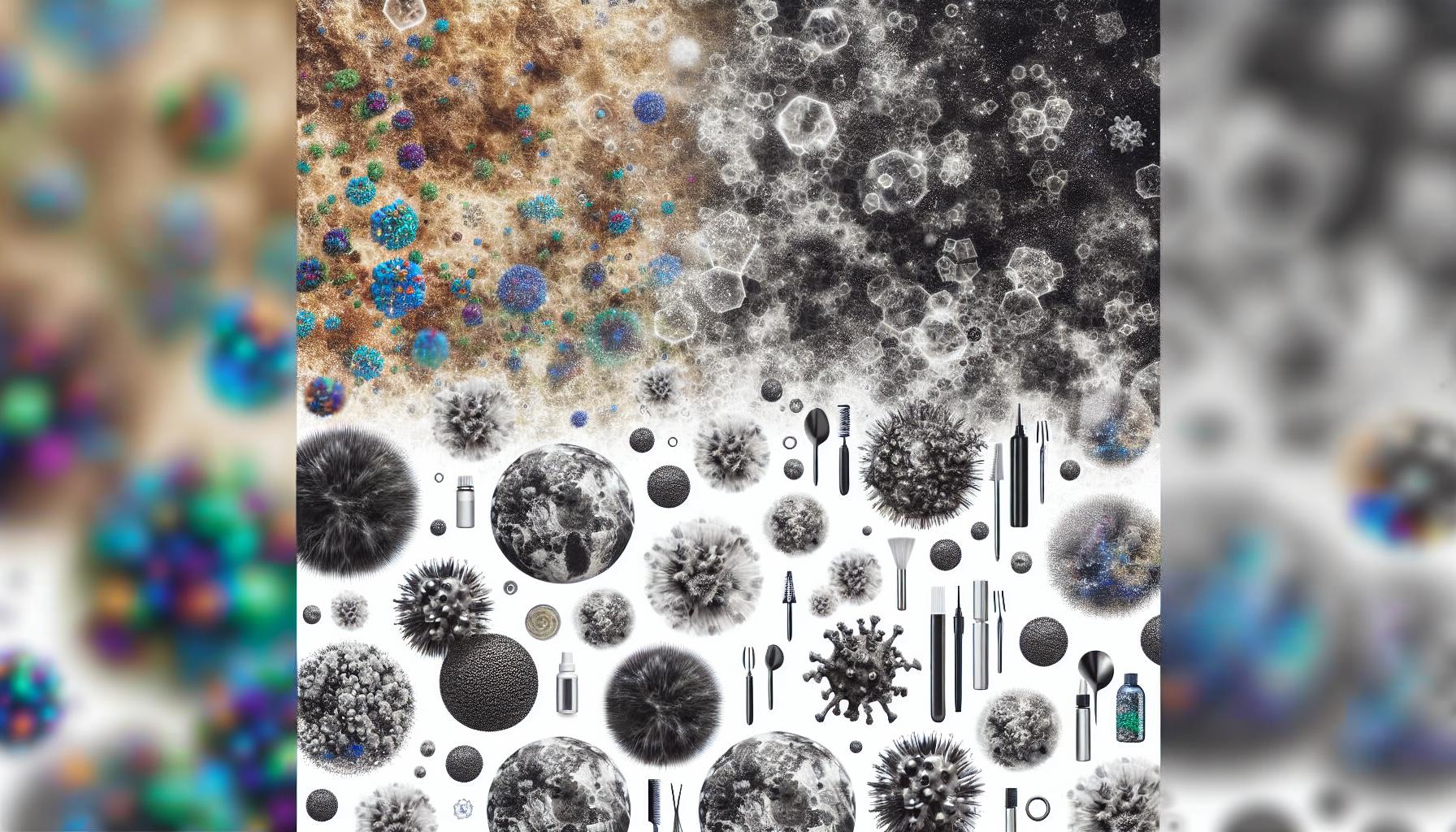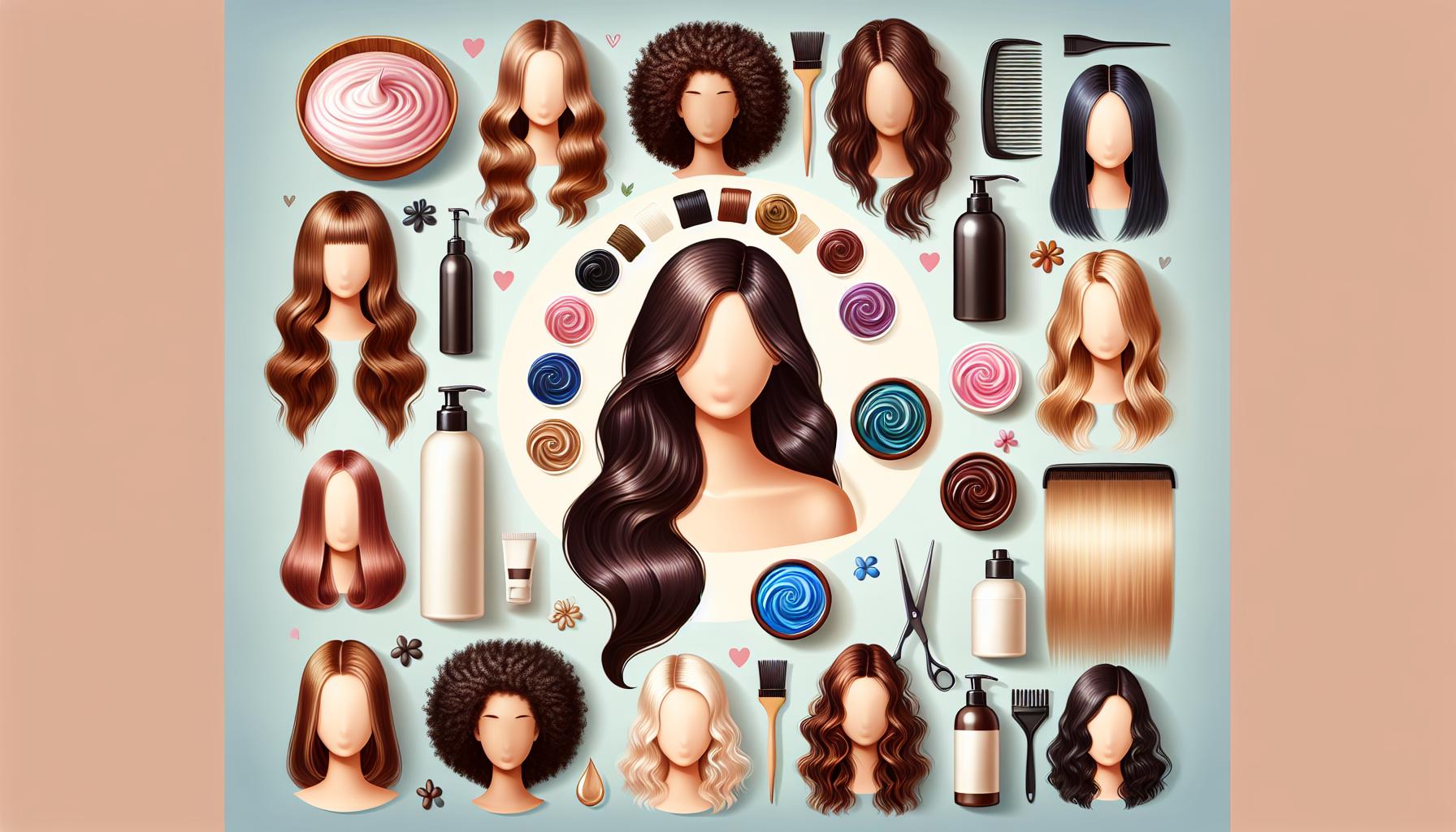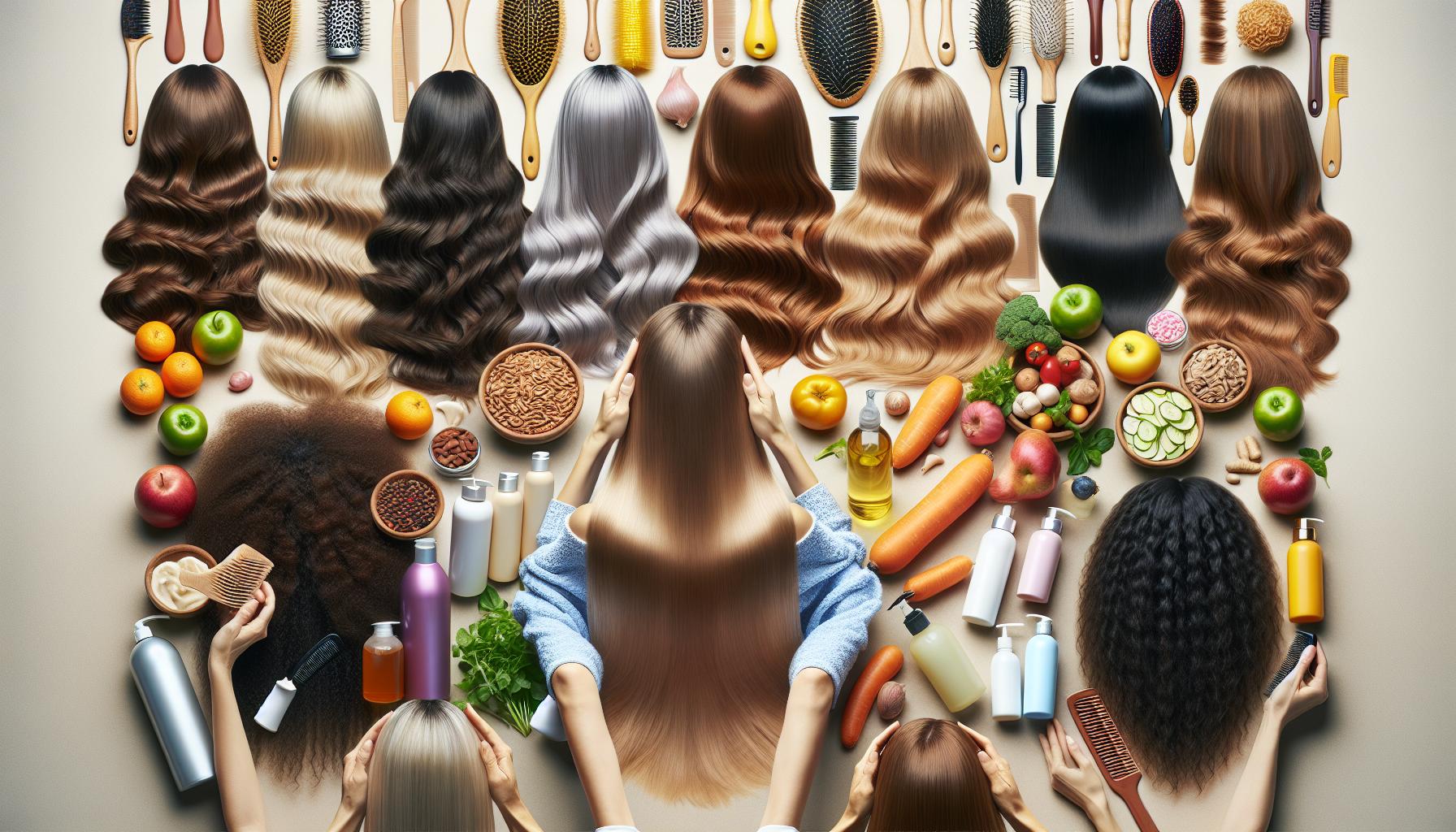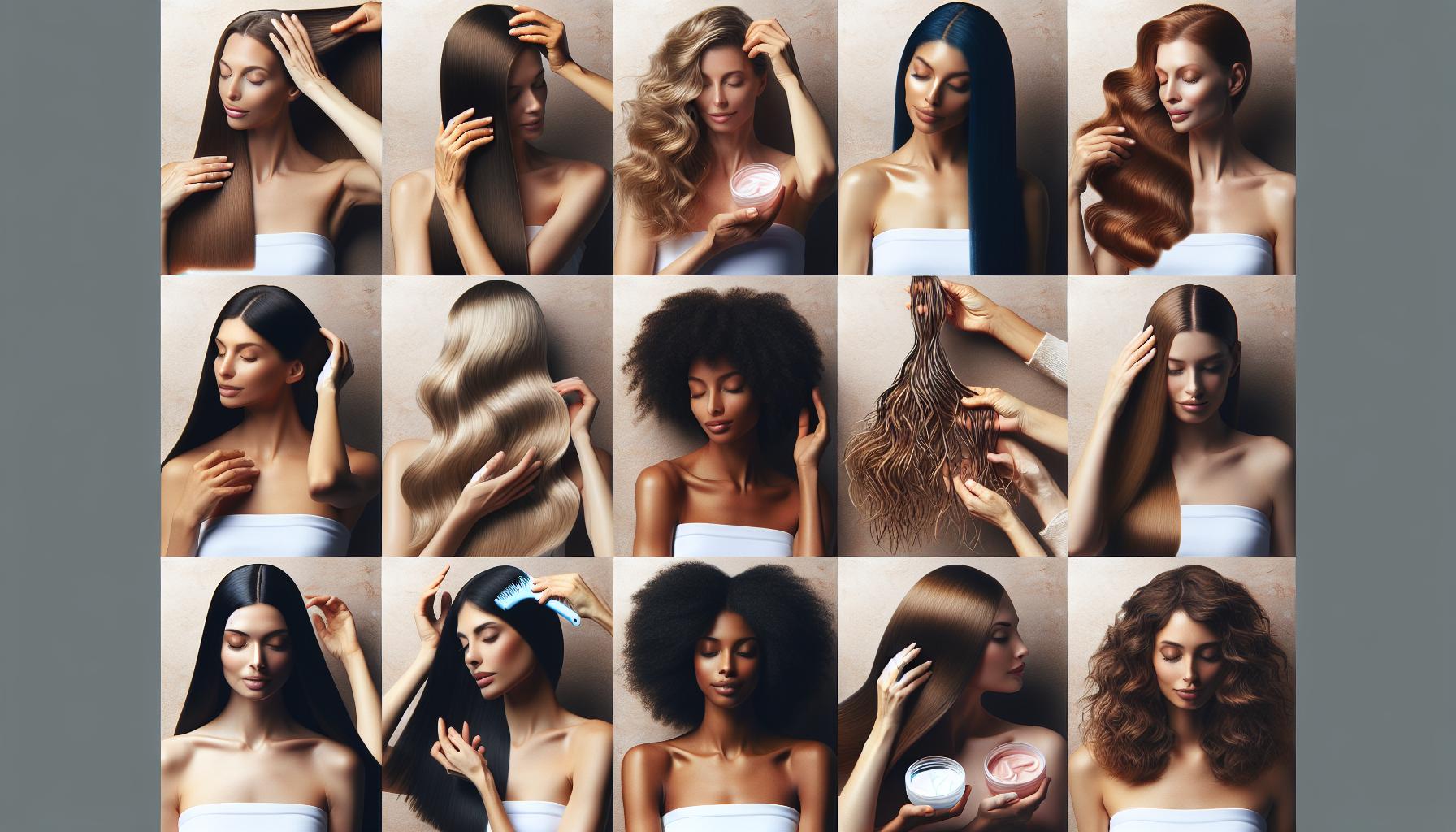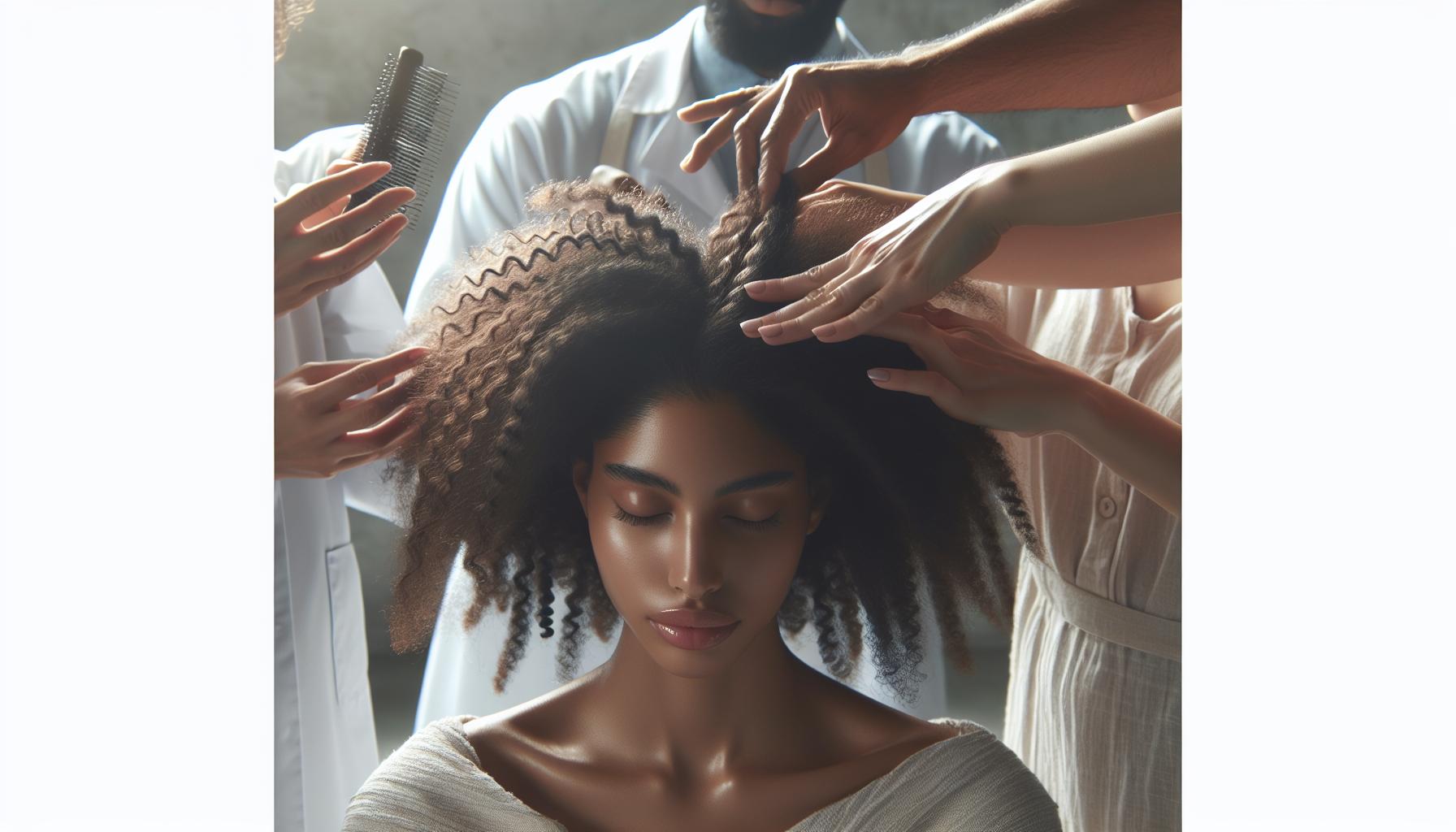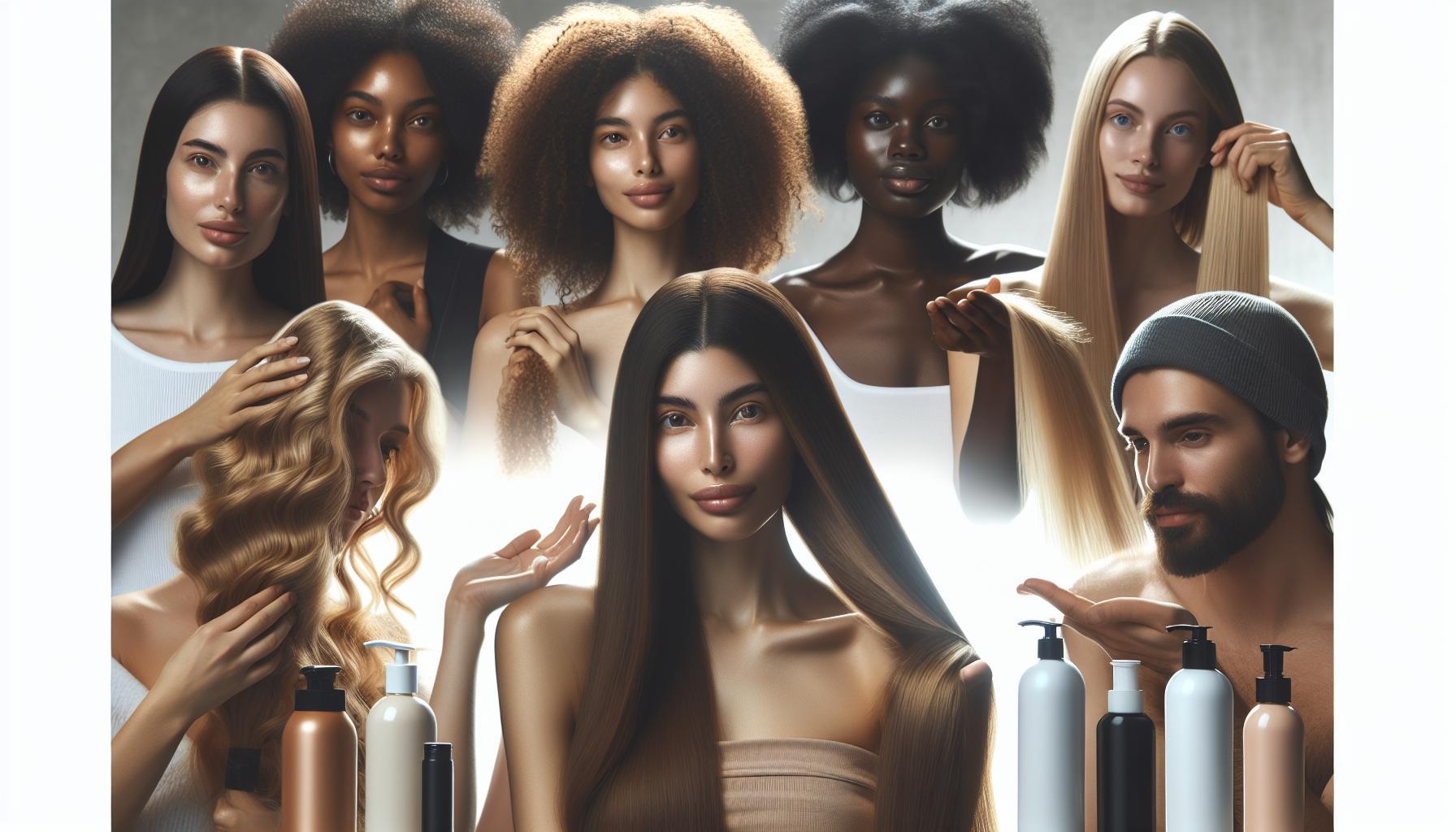Many seek to transform their look with vibrant hair colors, but conventional dyes often contain harsh chemicals. Fortunately, there are natural methods backed by science that can safely enhance your hair’s color. Discovering these alternatives is not only beneficial for your hair’s health but also aligns with a growing desire for sustainable beauty practices.
Contents
- Exploring the Basics: What Does “Natural Hair Color Change” Mean?
- The Science Behind Natural Hair Dyes: Ingredients You Can Trust
- Popular Natural Methods for Hair Color Change: Effectiveness and Safety
- herbal Remedies and Nutrient-Rich Treatments: Can They Really Work?
- The Role of Diet in Hair Color: Nourishing from the Inside Out
- Understanding Your Hair Type: How It affects Color Results
- Professional Insights: What Dermatologists Say About Natural Hair Coloring
- Success Stories: Real Experiences with Natural Hair Color Changes
- Frequently asked questions
- Can you change hair color naturally? Science-Backed Methods?
- What is the best natural method to lighten hair color?
- How does henna change hair color?
- Can I naturally darken my hair color?
- Why does hair color change naturally over time?
- What are the benefits of using natural hair color methods?
- Can I mix natural hair color methods?
- To Wrap It Up
Exploring the Basics: What Does “Natural Hair Color Change” Mean?
Changing your hair color naturally has been a pursuit for many, especially as awareness grows regarding the impact of synthetic dyes on both health and the surroundings. A meaningful aspect of understanding natural hair color change is recognizing how melanin, the pigment responsible for hair’s color, can be influenced through various eco-pleasant methods. From the traditional use of plant-based dyes to emerging scientific innovations, the journey of achieving a new hue without harsh chemicals is both fascinating and attainable.
One of the most discussed approaches involves the use of plant colorants, which have gained popularity due to their environmentally friendly properties. As more consumers seek healthier alternatives, these natural dyes provide an effective answer. As an example, ingredients such as henna, indigo, and various herbal extracts can not only change the color of hair but also improve its health. Unlike oxidative hair dyes, which can lead to damage, plant-based options are frequently enough perceived as biocompatible and nourishing. To explore this further, consider the following benefits of using natural hair colorants:
- Healthier hair: Many plant dyes contain vitamins and antioxidants that can enhance hair texture.
- Less irritation: Natural dyes tend to be gentler on the scalp,minimizing allergic reactions.
- Variety of shades: With the right combination of plants, a spectrum of colors can be achieved, from deep browns to vibrant reds.
In addition to botanical methods, researchers are exploring innovative ways to manipulate hair color using synthetic melanin. A study from Northwestern University introduced a method that utilizes enzymes to catalyze synthetic melanin, creating a wide array of colors that closely mimic natural shades. This cutting-edge science can potentially provide a solution for those looking to change their hair color without resorting to potentially harmful chemicals commonly found in traditional dyes [1].
Ultimately, the exploration of changing hair color naturally combines both ancient practices and modern science. Whether you opt for natural dyeing with plants or look into the possibilities of enzyme-catalyzed colorants, the methods available not only enhance your look but also promote a more sustainable approach to beauty. As consumer demand for eco-friendly products increases, the evolution of hair coloring techniques will continue to blend tradition with innovation, providing exciting options for the conscious individual.
The Science Behind Natural Hair Dyes: Ingredients You Can Trust
Natural hair dyes are becoming increasingly popular as consumers seek safer, eco-friendly alternatives to synthetic products. These dyes not only provide a way to change your hair color naturally but also often come with additional benefits for hair health. Understanding the ingredients in these natural dyes and how they work can help you unlock the secrets of vibrant hair color without harsh chemicals.
Key Ingredients in Natural Hair Dyes
natural hair dyes primarily derive their coloring properties from various plant-based ingredients.Some of the most common sources include:
- Henna: Perhaps the most well-known natural dye, henna is obtained from the leaves of the henna plant. It imparts a rich reddish-brown color and can condition hair, making it softer and shinier. To use henna,mix about 1/2 cup with 1/4 cup of water,adjusting for consistency. This ancient dye has been used for centuries across cultures for body art and hair coloring[[[1]](https://www.healthline.com/health/natural-hair-dye).
- Indigo: Frequently enough combined with henna for a darker shade, indigo comes from the leaves of the indigo plant. When used correctly, it can create shades ranging from dark brown to black. The two dyes can be layered for a multi-dimensional color effect.
- Beetroot and Carrot Juice: For those seeking vibrant reds and oranges, beetroot and carrot juice can act as temporary dyes. They are particularly suitable for lighter hair tones and can be mixed with conditioners for a gentle treatment.
- Chamomile: This flower not only provides a lovely, fragrant infusion but can also lighten blonde hair naturally. A chamomile rinse can give hair a sun-kissed glow, especially when used in conjunction with sunlight.
The Benefits of Choosing Natural Dyes
The rising awareness of the potential health risks associated with synthetic hair dyes has sparked interest in natural alternatives. Ingredients like henna and indigo are generally considered biocompatible, which means they are less likely to cause allergic reactions or adverse effects compared to their chemical counterparts [[2]](https://www.sciencedirect.com/science/article/pii/S2352554123003194). Additionally, many plant-based dyes offer conditioning benefits, as they can nourish and strengthen hair rather than drying it out.
Moreover, the sustainable nature of plant-based dyes aligns with the growing trend toward eco-conscious living. as synthetic dyes can be derived from non-renewable sources and frequently enough involve harsh manufacturing processes, opting for natural colorants enables consumers to support a more holistic and environmentally friendly approach to personal care.
Creating Your own Natural Dye
For those intrigued by the idea of making their own hair dye, experimenting with natural ingredients can be a rewarding endeavor. Here’s a simplified process for creating a henna-based hair dye at home:
| Ingredient | Amount |
|---|---|
| Henna Powder | 1/2 cup |
| Water | 1/4 cup (adjust as needed for consistency) |
Combine these ingredients to achieve a paste-like consistency, then apply to clean, dry hair. After leaving it in for several hours (which can vary depending on the desired depth of color),rinse thoroughly.remember to perform a patch test to ensure there are no sensitivities to any ingredients before applying the dye broadly.
Through this exploration, it becomes evident that the world of natural hair dyes is rich with possibilities. Whether you are addressing the question of “Can you change hair color naturally? Science-Backed Methods” for health reasons or simply seeking a vibrant new look, the science behind these ingredients reveals a wealth of options that are both beautiful and beneficial.
Popular Natural Methods for Hair Color Change: Effectiveness and Safety
In a world increasingly leaning towards natural and organic products,many people are exploring alternatives to traditional hair dyes. Natural methods for altering hair color not only minimize exposure to harsh chemicals but also offer unique results that reflect individual beauty. Exploring options such as henna, indigo, and other plant-based dyes allows you to change your hair color effectively and safely, providing a compelling reason to consider these alternatives.
Popular Natural Colorants
- Henna: This ancient dye is derived from the leaves of the Lawsonia inermis plant.Henna imparts a rich reddish-brown tone that can be deepened or muted with various additives, making it one of the most popular natural hair dyes.
- Indigo: Frequently enough used in conjunction with henna, indigo creates a beautiful blue-black or dark brown shade. Applying henna first followed by indigo can yield stunning dark shades while maintaining the health of your hair.
- Coffee and Tea: Brewed coffee and tea can naturally darken hair, with stronger brews lending richer tones.These methods are simple and risk-free, making them an excellent choice for temporary color changes.
- Beet and Carrot Juice: For those seeking vibrant red hues, beet and carrot juices are excellent options. Both provide beautiful shades while nourishing hair with vitamins.
Effectiveness and Safety Considerations
While natural methods for hair color change can be effective, their results may vary based on hair type and the specific products used.Chemical dyes often provide louder, more immediate results, but they come with risks that natural alternatives do not. According to research, natural dyes may require more time and effort in their application, but the benefits include reduced risk of allergic reactions and long-term health concerns associated with synthetic dyes, such as potential links to certain cancers[[[1]](https://cookingpro.net/is-hair-color-shampoo-safe/) [[2]](https://www.hilarispublisher.com/open-access/comparative-study-of-chemical-vs-natural-hair-dyes-safety-and-efficacy-111031.html).
For optimal results with natural dyes, consider conducting a strand test before full application to determine how your hair will react. Natural coloring may take longer to develop fully compared to chemical dyes; patience is essential for achieving the desired look.Incorporating pre- and post-color treatments, such as conditioning masks and oils, can also help maintain hair health throughout the dyeing process.embracing natural methods for hair color change not only aligns with a healthier lifestyle but also offers a creative outlet for individual expression. Many find that while they may require more commitment and experimentation, natural alternatives provide a satisfying and safe way to enjoy vibrant hair.
herbal Remedies and Nutrient-Rich Treatments: Can They Really Work?
To many, the idea of transforming hair color without resorting to harsh chemicals evokes a sense of curiosity and hope. Natural herbal remedies and nutrient-rich treatments offer a gentle choice, potentially enriching both hair health and color in a holistic manner. Exploring various herbal solutions can unveil their effectiveness in enhancing and altering hair color, allowing individuals to embrace a more natural beauty routine.
Herbal Remedies: Nature’s Palette
Utilizing herbs for hair coloring taps into centuries of tradition where natural ingredients served as versatile tools for beauty and wellness. Among the popular options, henna stands out, known for providing a deep, rich color. While it predominantly imparts an orange-copper hue on gray hair, many users appreciate its conditioning properties along with its color effects. Combining henna with other botanicals, such as indigo, can further modify the shade towards darker tones, creating personalized color results.
Other notable herbs include:
- Rosemary: Frequently enough cited for its ability to promote scalp health, rosemary can also enhance dark hair and help mask grays.
- Sage: This herbal remedy is believed to naturally darken hair over time while improving scalp vitality.
- Black tea: Rich in tannins, it can add depth and darkness to hair, making it an easy home remedy.
nutrient-Rich Treatments: Beyond Color
In addition to aesthetic benefits, many herbal treatments are packed with nutrients that can rejuvenate the hair. Ingredients like aloe vera, coconut oil, and avocado are not only excellent conditioners but also provide essential vitamins and antioxidants, promoting healthier hair growth and overall scalp health. Such nutrient-rich treatments not only support the goal of changing hair color but also enhance the structure and resilience of the hair, mitigating the damage frequently enough associated with chemical dyes.
To see real results, it’s important to be consistent with these natural treatments. Regular applications can gradually change hair color,while also rendering it shinier and more vibrant. As a notable example, an oatmeal and honey mask nourishes the scalp and can provide subtle lightening effects over time, while regular rinses with sage tea can deepen color without chemical reactions.
The Verdict: Can You Change Hair Color Naturally?
While herbal remedies and nutrient-rich treatments may not yield instantaneous transformations comparable to commercial dyes, they offer a safe, health-conscious alternative for those looking to revitalize their hair naturally.The science behind these methods lies not only in the visible outcomes but in their holistic approach to hair health. Committing to a regimen of herbal treatments can lead to noticeable changes, allowing users to embrace their unique journey towards vibrant, healthier hair without the collateral damage associated with synthetic dyes.
For those curious about whether they can genuinely change hair color naturally, experimenting with these botanicals can provide both a visually pleasing outcome and a nourishing experience for the hair.
The Role of Diet in Hair Color: Nourishing from the Inside Out
A diet rich in essential nutrients can play a significant role in both the health of your hair and its color. Although genetics largely determine your hair color, certain foods can influence melanin production, which is the pigment responsible for hair color. By nourishing your body with the right vitamins and minerals, you may enhance your natural hue while promoting overall hair vitality.
The Connection Between Diet and Hair color
Eating a balanced diet that includes a variety of vitamins and minerals can definitely help support the production of melanin. For instance, foods rich in B vitamins, folic acid, and omega-3 fatty acids are essential for maintaining not just hair health but also the richness of its color. Incorporating the following foods into your diet can serve as an effective way to support your hair’s natural tone:
- Leafy Greens: Spinach and kale are high in vitamins A and C, which promote sebum production, aiding in healthy hair growth.
- Berries: Rich in antioxidants,berries help fight oxidative stress which can affect hair color over time.
- Fish: Salmon and mackerel are not only excellent sources of omega-3 fatty acids but also enhance overall scalp health.
- Nuts and Seeds: almonds and sunflower seeds are packed with vitamin E, which can improve scalp circulation and hair quality.
Key Nutrients for Enhancing hair Color
To effectively change hair color naturally, focus on the following nutrients that have been shown to influence hair pigmentation:
| Nutrient | Benefits |
|---|---|
| B Vitamins | Essential for melanin production and overall hair health. |
| Folic Acid | Promotes healthy cell division, critical for hair follicle regeneration. |
| Vitamin D | Necesary for the formation of new hair follicles. |
| Iron | Helps prevent hair loss and supports overall hair health. |
Integrating these foods and nutrients into your daily meals is a proactive approach to not only enhance your natural hair color but also maintain its strength and vitality. While you might not see dramatic changes overnight, consistent dietary choices can lead to healthier and potentially more vibrant hair over time. By focusing on nourishing your body from the inside out, you embrace a holistic method to achieve the vibrant locks you desire.
Understanding Your Hair Type: How It affects Color Results
Understanding your unique hair type is essential when considering a color change, especially if you’re exploring natural options. Different hair textures and structures can substantially influence how color treatments are absorbed and displayed on your strands. As an example, porous hair typically absorbs color more readily but may also lead to uneven results or faster fading, while coarse hair might resist color penetrating the cuticle, requiring different techniques to achieve the desired outcome.
Hair Texture and Color Results
The relationship between hair type and color results can be fascinating.Here are some key points to consider:
- Straight Hair: Often reflects light better, which can enhance vibrancy. However, it might require more processing time for color to penetrate.
- Wavy Hair: Offers a balance between texture and vibrancy, usually holding color well, especially for semi-permanent options.
- Curly Hair: Texture can create engaging challenges. The curls may trap color, leading to more vibrant results, but they are also more prone to dryness.
- Kinky Hair: Tightly coiled textures tend to be more porous, demanding careful handling to prevent over-processing or breakage when coloring.
Each hair type also interacts uniquely with color formulations. Such as,products suitable for naturally straight hair might not be effective for fine,curly types. Understanding these nuances can enhance your approach to achieving that desired hue.
The Impact of Hair Care Products
Along with the inherent characteristics of your hair,the choice of hair care products can further influence color outcomes. Using:
| Product Type | Impact on Color |
|---|---|
| Moisturizing Shampoo | Helps maintain hydration for better color retention |
| Color-Protecting Conditioner | seals in color and prevents fading |
| Heat Protection Spray | Reduces damage from styling tools that can strip color |
The combination of your hair type and the right products can lead to successful color transformations, even when implementing science-backed methods to change hair color naturally. By paying close attention to your hair’s needs, you can navigate this complex process and enjoy beautiful, vibrant results without compromising the health of your hair.
Professional Insights: What Dermatologists Say About Natural Hair Coloring
Changing hair color naturally has gained popularity as more individuals seek healthier alternatives to chemical dyes.Dermatologists emphasize the importance of understanding both the benefits and limitations of natural hair coloring methods. While many products are marketed as “natural,” it’s crucial to discern their effectiveness and safety for the scalp and hair health.
Safe and Effective Natural Dyes
Many dermatologists recommend exploring natural dyes that utilize plant-based ingredients, as they are less likely to cause irritation compared to traditional dyes containing PPD (para-phenylenediamine) and ammonia. Common natural coloring agents include:
- Henna: A well-known herbal dye that provides rich red tones and conditioning benefits.
- Indigo: Frequently enough used in combination with henna to achieve darker shades.
- Chamomile: Used for achieving lighter, golden hues, especially for blonde hair.
hair experts note that while these options can provide beautiful color, achieving significant color change might require repeated applications or combinations of different natural agents, which can alter the effectiveness over time.
Patch Testing is Key
Before committing to any natural hair dye, dermatologists stress the importance of patch testing. Even natural products can lead to allergic reactions. A simple skin patch test can prevent potential adverse effects. Apply a small amount of the dye on a discreet area and monitor for reactions over 48 hours.
managing Expectations
It’s essential for consumers to manage their expectations when utilizing natural methods for hair coloring. Dermatologist Karan Lal highlights that while these methods can yield satisfactory results, they may not match the vibrancy or longevity of traditional dyes. Thus, users should be prepared for less dramatic changes and the possibility of needing frequent touch-ups. This approach aligns with the overarching question – can you change hair color naturally? Evidence suggests a cautious yes, but it comes with the understanding that results may vary significantly based on hair type and previous treatments.
By understanding these professional insights, you can make informed decisions on how to approach natural hair coloring, ensuring a balance between aesthetic desires and hair health.
Success Stories: Real Experiences with Natural Hair Color Changes
Changing hair color naturally is not just about aesthetics; it can also be a transformative journey toward personal empowerment. Many individuals have shared their inspiring stories and effective strategies for embracing their natural hair color changes, highlighting the viability of science-backed methods.One such method is the gradual transition to gray or silver hues, often initiated in response to lifestyle changes or allergies to traditional hair dyes.
Real Experiences and Transformations
A notable case is that of Lisette, who began her transition to gray hair at the age of 44 due to developing an allergic reaction to hair dye. She noted, “After dyeing my hair every 2.5 to 3 weeks for countless years, I realized that moving towards my natural color not only made my hair healthier but also reclaimed my confidence.” By choosing to let her natural color grow in, Lisette found that the rough patches of transition were worthwhile, leading to stunning silver locks that she now proudly showcases.
Similar stories are shared by others who have opted for a natural approach.As a notable example, Janice embraced her natural color and experienced a newfound love for her hair, stating, “You might encounter some struggles during the process, but trust me, it’s rewarding in the end.” This appeals to those hesitant about letting go of chemical dyes, as it underscores the essence of patience and self-love during the transition.
Science-Backed Methods for Natural Color Changes
The success of these journeys often hinges on a few science-backed methods that facilitate a smooth transition. Here are a few tips that individuals have found beneficial:
- Embrace Natural Remedies: Incorporating natural oils like coconut or argan oil can enhance hair softness and shine while encouraging the natural color to come through.
- Regularly Condition: Keeping hair well-hydrated with natural conditioners can lessen the visible contrast during the transitional phase.
- Seek Professional Guidance: Consulting with hairstylists who specialize in natural color transitions can offer tailored solutions, aiding in faced challenges.
Ultimately,the experience of shifting hair colors naturally is highly individual. Each story serves as a testament to the possibility of change without reliance on harsh chemicals, encouraging many to ask the question, “Can you change hair color naturally?” The answer increasingly appears to be a resounding yes, especially when supported by a community of like-minded individuals sharing their journeys.
Frequently asked questions
Can you change hair color naturally? Science-Backed Methods?
Yes, you can change your hair color naturally using methods like herbal rinses, lemon juice, or henna. These methods are gentler on your hair compared to chemical dyes and offer subtle changes over time.
Many natural ingredients are known to enhance or alter hair color. For instance, henna provides a rich red tint, while chamomile can lighten blond hair. These options are particularly appealing for those looking for a temporary or organic approach.
What is the best natural method to lighten hair color?
Lemon juice is one of the most popular natural methods to lighten hair. Its acidic properties help in gradually achieving lighter shades when exposed to sunlight.
For effective results, mix lemon juice with water and apply it to your hair before spending time outdoors. Keep in mind that this method may work best on lighter hair shades and can lead to dryness, so ensure you use a moisturizing conditioner afterward.
How does henna change hair color?
Henna changes hair color by coating the hair shaft with a natural dye derived from the leaves of the henna plant, providing a reddish-brown tint.
This plant-based dye not only colors but also conditions hair, making it a popular choice for those looking for eco-friendly options. Keep in mind that results can vary depending on your original hair color and the brand of henna used.
Can I naturally darken my hair color?
Yes, you can naturally darken your hair using ingredients like black tea or coffee.Both can give darker tones without the harmful effects of chemical dyes.
To use, brew a strong batch of tea or coffee, let it cool, and apply it to your hair. Leave it in for at least 30 minutes before rinsing for best results. This method is temporary and may require regular application for maintenance.
Why does hair color change naturally over time?
Hair color changes naturally due to factors such as age, genetics, and environmental exposure.As we age, our bodies produce less melanin, leading to graying.
Sun exposure can also lighten hair, while changes in health or hormone levels may affect pigmentation. Understanding these factors can definitely help you embrace your natural color changes over time.
What are the benefits of using natural hair color methods?
Using natural hair color methods reduces the risk of damage associated with harsh chemicals in traditional dyes and promotes healthier hair.
Additionally, these methods can yield more subtle, customizable results and frequently enough come with conditioning benefits, which is a major plus for anyone looking to maintain hair health while changing their color.
Can I mix natural hair color methods?
Yes, mixing natural hair color methods can enhance results. such as, combining henna with indigo creates a richer brown shade.
Experimenting with combinations like chamomile and honey for lightening or using coffee after henna treatment for a darker shade can lead to beautiful, personalized results. Always test a small strand first to see how your hair reacts.
To Wrap It Up
Changing your hair color naturally is an exciting journey that opens up a world of creative possibilities while prioritizing your hair’s health. Throughout our discussion, we’ve highlighted various science-backed methods, such as using plant-based dyes like henna and beet juice, which not only provide color but also nourish and strengthen your hair. We’ve explored the efficacy of everyday items like coffee and lemon juice, showcasing practical ways you can experiment with shades right at home.
Remember, while these methods can yield beautiful results, they also require patience and care to achieve the desired outcome. The beauty of going natural lies not just in the color change but also in preserving the integrity of your hair and minimizing exposure to harsh chemicals.
We encourage you to explore these methods further, understanding that each technique can cater to unique hair types and goals. Whether you’re ready to dive into the world of DIY natural dyes or prefer to seek out organic hair color brands, every step you take towards a more natural hair care routine is a victory for your hair and your well-being. Embrace the journey of self-expression and let your hair reflect the vibrant individual you are!

